|
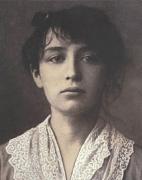
Camille Claudel,
portrait by Cesar
|
Not only is Camille 24 years younger
than Rodin; her mother and her brother Paul are suspicious
of the artist, who is slowly coming to fame now. One of
the things their hear about the sculptor disturbs them:
apparently, Rodin has a wife already. Although Rodin
adores Camille, employs her in his studio, takes her as a model for various sculptures like The
Thought, La France and Saint George,
spends the summer days with her at the Château d´Islette
and pays the rent for her house near the Dépôt des
Marbres, he does not want to dissolve his ties to his
old love and companion Rose Beuret. Rose had been loyal to
him during the difficult years in Belgium, she had watched
over his precious clay models and been his model for
Mignon and La Bacchante.
|
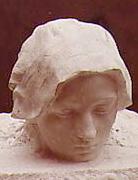
Thought Bulloz,
gelatin silver print
28,5 x 38,2 cm
Musée Rodin, Ph. 636
|
|
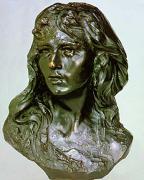
Mignon (Mme Rodin)
1867-68, bronze
Rodin Museum Philadelphia
|
On 22 January 1866,
their son Auguste-Eugène Beuret had been born. Rodin
never recognised him as his child, nor was he prepared to
marry Rose. Still, he does not want to
leave her alone. Together with Rose, he lives at the Rue
des Grands Augustins. At the same time,
Rodin and Camille share an atelier in the Folie
Neufborg, a little old castle at the Boulevard
d´Italie.
They are an artistic, sexual and spiritual
pair. Camille still hopes she can replace
Rose, who does hardly participate in Rodin´s
social and intellectual life and rather functions
as a kind of housekeeper.
Matthias Morhardt recalls:
|
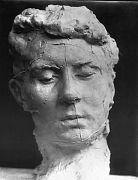
La Tête de Rose, plaster, 1880-82;
papier albuminé
|
|
"She wanted Rodin to repudiate
his poor old Rose, who had been the companion of
his early years, and who had shared his poverty.
He could not bring himself to to that, though both
as a man and an artist he was passionately in love
with Camille Claudel. "She has no sense of
fair play", he told me one day, "just
like all women."
 Matthias Morhardt, quoted by Frederic Grunfeld,
Rodin - A Biography, p. 230
Matthias Morhardt, quoted by Frederic Grunfeld,
Rodin - A Biography, p. 230
|
|
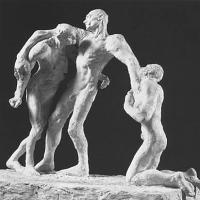 Camille´s friend Jessie
Lipscomb recollects, Rodin had two children with
Camille, who were raised in a boarding
school, but a curious contract of October
1886, in which Rodin promised to give up all
contact to his former models and to marry Camille,
never is fulfilled. In 1893, Rodin moves with
Rose to the Villa Bellevue in Meudon. Camille does not
give up, though: she does not want confine herself to the
role of a mistress and assistant. According to Georges Reyer,
there are impetuous scenes of jealousy, and
Kenneth Clark wrote that one day, Rose even shot
at Camille. In
L´Age Mûr (1894), Camille Claudel depicts this
fatal triangle relationship between Rodin, Rose, and herself.
In biting caricature sketches, she comments on Rodin´s
unwillingness to give up Rose. Finally, she starts to move
away from Rodin, develops her new concept of narrative
sculpture. Camille´s friend Jessie
Lipscomb recollects, Rodin had two children with
Camille, who were raised in a boarding
school, but a curious contract of October
1886, in which Rodin promised to give up all
contact to his former models and to marry Camille,
never is fulfilled. In 1893, Rodin moves with
Rose to the Villa Bellevue in Meudon. Camille does not
give up, though: she does not want confine herself to the
role of a mistress and assistant. According to Georges Reyer,
there are impetuous scenes of jealousy, and
Kenneth Clark wrote that one day, Rose even shot
at Camille. In
L´Age Mûr (1894), Camille Claudel depicts this
fatal triangle relationship between Rodin, Rose, and herself.
In biting caricature sketches, she comments on Rodin´s
unwillingness to give up Rose. Finally, she starts to move
away from Rodin, develops her new concept of narrative
sculpture.
 Renate Berger, Camille Claudel in ihrer Zeit, in: Camille Claudel, Skulpturen, Gemälde, Zeichnungen, Edition Stadtbaukunst, 1990, p.
16 ff. See also J.A. Schmoll, Auguste Rodin and Camille Claudel, Prestel Verlag, p. 35.
For the most complete information on Camille Claudel, see
the publications and exhibitions initiated by Reine-Marie
Paris, Paul Claudel´s granddaughter.
Renate Berger, Camille Claudel in ihrer Zeit, in: Camille Claudel, Skulpturen, Gemälde, Zeichnungen, Edition Stadtbaukunst, 1990, p.
16 ff. See also J.A. Schmoll, Auguste Rodin and Camille Claudel, Prestel Verlag, p. 35.
For the most complete information on Camille Claudel, see
the publications and exhibitions initiated by Reine-Marie
Paris, Paul Claudel´s granddaughter.
By the time the monumental
version of The Kiss is presented at the 1898 Salon,
their liaison has ended, although Rodin continues to
support her artistic reputation. Camille, sliding into
paranoia, suspects Rodin is abusing her ideas, even leads
a conspiracy to poison her. In March 1913, after the death
of her father, Camille is delivered to the mental hospital
Ville-Evrard. Till her death in 1943, she will stay in
custody, deprived of her art. In January 1917, Rodin and
Rose finally marry, two weeks before Rose´s death.
|